Rethinking Productivity Evaluation in Precision Forestry through Dominant Height and Site Index Measurements Using Aerial Laser Scanning LiDAR Data
Abstract
1. Introduction
1.1. Loblolly’s Pine Importance
1.2. Dominant Height as a Measure of Productivity
- Mean height for a given percentage of the tallest trees;
- Mean height for a given number of the tallest trees as defined by size/density;
- The tallest single tree height.
1.3. Stand Characterization with Remote Sensing Data
1.4. Use of Remote Sensing in Precision Forestry
- Assess how scale impacts these estimates for loblolly pine plantations;
- Compare different definitions of dominant height;
- Evaluate methods for stand stratification (e.g., soils, topography, and soils plus topography), relative to simulations of traditional field inventory sample plot data.
2. Materials and Methods
2.1. Site Locations
2.2. Soils and Geology
2.3. Data Collection and Processing
- Valleys—value of less than one negative standard deviation of the TPI;
- Flat—value greater than or equal to one negative standard deviation but less than one half standard deviation of the TPI;
- Ridge—value greater than one half standard deviation of the TP.
2.4. Data Analysis
2.4.1. Dominant Height Definitions
- Top HT 85—mean height of the 85th percentile of tallest trees;
- Top HT 100—mean height of the tallest 100 trees per hectare within the stand;
- Top HT 40—mean height of the tallest 40 trees per hectare within the stand.
| Location | Stand | Area (ha) | Number of Trees | Mean Trees per Hectare | Mean Tree Height (m) | Number of Plots Simulated |
|---|---|---|---|---|---|---|
| AL | ALNorth1 | 49.1 | 35,537 | 724 | 17.3 (1.9) | 22 |
| ALSouth1 | 20.4 | 19,154 | 938 | 17.2 (1.6) | 9 | |
| NC | NCSouth1 | 51.5 | 15,136 | 294 | 21.2 (1.7) | 26 |
| NCSouth2 | 13.0 | 5260 | 404 | 17.0 (1.4) | 9 | |
| NCNorth1 | 16.7 | 7296 | 437 | 17.3 (1.5) | 9 | |
| NCNorth2 | 56.5 | 22,723 | 400 | 17.2 (1.7) | 31 | |
| TX | TXSouth1 | 52.3 | 19,061 | 365 | 17.7 (1.2) | 24 |
| TXSouth2 | 35.8 | 18,585 | 519 | 22.0 (2.0) | 16 |
2.4.2. Scale
- Full stand: dominant trees are selected from the tree population for each stand without stratification.
- Soil classification: dominant trees are selected from the tree population for each soil type.
- Microtopography classification: dominant trees are selected from the tree population for each microtopography type.
- Combined soil and microtopography classification: dominant trees are selected from the tree population for each combination of soil and microtopography.
2.4.3. Site Index
3. Results
3.1. Dominant Height Definition
3.2. Scale
3.2.1. Soils
3.2.2. Microtopography
3.2.3. Soils and Microtopography
3.3. Site Index
4. Discussion
4.1. Productivity Definition
4.2. Dominant Height
4.3. Influence of Site Variability on Dominant Height
4.4. Precision Forestry Using Remote Sensing Data
5. Conclusions
Author Contributions
Funding
Data Availability Statement
Acknowledgments
Conflicts of Interest
References
- Oswalt, S.N.; Smith, W.B.; Miles, P.D.; Pugh, S.A. Forest Resources of the United States, 2017; General Technical Report; US Department of Agriculture, Forest Service: Washington, DC, USA, 2019.
- Kandare, K.; Ørka, H.O.; Dalponte, M.; Næsset, E.; Gobakken, T. Individual Tree Crown Approach for Predicting Site Index in Boreal Forests Using Airborne Laser Scanning and Hyperspectral Data. Int. J. Appl. Earth Obs. Geoinf. 2017, 60, 72–82. [Google Scholar] [CrossRef]
- Tasissa, G.; Burkhart, H.E.; Amateis, R.L. Volume and Taper Equations for Thinned and Unthinned Loblolly Pine Trees in Cutover, Site-Prepared Plantations. South. J. Appl. For. 1997, 21, 146–152. [Google Scholar] [CrossRef]
- Restrepo, H.I. Modeling Loblolly Pine (Pinus taeda L.) Stand Dynamics and Its Associated Financial Implications for Forestland Owners in the Southeastern U.S. Ph.D. Thesis, University of Georgia, Athens, GA, USA, 2019. [Google Scholar]
- Burkhart, H.E.; Tomé, M. Modeling Forest Trees and Stands, 1st ed.; Springer: Dordrecht, The Netherlands, 2012; ISBN 978-90-481-3170-9. [Google Scholar]
- Hart, H.M.J. Stamtal en Dunning: Een Oriënteerend Onderzoek Naar de Beste Plantwijdte en Dunningswijze Voor den Djati; Veenman & Zonen: Wageningen, The Netherlands, 1928. [Google Scholar]
- Becking, J.H. Thinning Research in Forestry. Neth. J. Agric. Sci. 1953, 1, 122–129. [Google Scholar] [CrossRef]
- Rennolls, K. Forest Height Growth Modelling. For. Ecol. Manag. 1978, 71, 217–225. [Google Scholar] [CrossRef]
- Loetsch, F.; Zöhrer, F.; Khaller, K.Ė. Inventory Data Collected by Terrestrial Measurements and Observations, Data Processing in Forest Inventory. The Sample Plot, Plotless Sampling and Regeneration Survey. List Sampling with Unequal Prbabilities and Planning, Performance and Field Checking of Forest Inventries; BLV Verlagsgesellschaft: Munich, Germany, 1973; ISBN 3-405-10812-8. [Google Scholar]
- Orrego, S.; Montes, C.; Restrepo, H.I.; Bullock, B.P.; Zapata, M. Modeling Height Growth for Teak Plantations in Colombia Using the Reducible Stochastic Differential Equation Approach. J. For. Res. 2021, 32, 1035–1045. [Google Scholar] [CrossRef]
- Strand, L. Numerical Constructions of Site-Index Curves. For. Sci. 1964, 10, 410–414. [Google Scholar]
- Silva, C.A.; Hudak, A.T.; Vierling, L.A.; Loudermilk, E.L.; O’Brien, J.J.; Hiers, J.K.; Jack, S.B.; Gonzalez-Benecke, C.; Lee, H.; Falkowski, M.J.; et al. Imputation of Individual Longleaf Pine (Pinus palustris Mill.) Tree Attributes from Field and LiDAR Data. Can. J. Remote Sens. 2016, 42, 554–573. [Google Scholar] [CrossRef]
- Rahman, M.A.; Bakar, M.A.; Razak, K.; Rasib, A.; Kanniah, K.; Kadir, W.W.; Omar, H.; Faidi, A.; Kassim, A.; Latif, Z.A. Non-Destructive, Laser-Based Individual Tree Aboveground Biomass Estimation in a Tropical Rainforest. Forests 2017, 8, 86. [Google Scholar] [CrossRef]
- Narin, O.G.; Vatandaslar, C.; Abdikan, S. Estimating Stand Top Height Using Freely Distributed ICESat-2 LiDAR Data: A Case Study from Multi-species Forests in Artvin. Forestist 2022, 72, 294–298. [Google Scholar] [CrossRef]
- Sumnall, M.J.; Albaugh, T.J.; Carter, D.R.; Cook, R.L.; Hession, W.C.; Campoe, O.C.; Rubilar, R.A.; Wynne, R.H.; Thomas, V.A. Estimation of Individual Stem Volume and Diameter from Segmented UAV Laser Scanning Datasets in Pinus taeda L. Plantations. Int. J. Remote Sens. 2023, 44, 217–247. [Google Scholar] [CrossRef]
- Rahman, M.Z.A.; Kadir, W.H.W.; Rasib, A.W.; Ariffin, A.; Razak, K.A. Integration of High Density Airborne LiDAR and High Spatial Resolution Image for Landcover Classification. In Proceedings of the 2013 IEEE International Geoscience and Remote Sensing Symposium-IGARSS, Melbourne, Australia, 21–26 July 2013; pp. 2927–2930. [Google Scholar]
- Kellner, J.R.; Armston, J.; Birrer, M.; Cushman, K.C.; Duncanson, L.; Eck, C.; Falleger, C.; Imbach, B.; Král, K.; Krůček, M.; et al. New Opportunities for Forest Remote Sensing Through Ultra-High-Density Drone Lidar. Surv. Geophys. 2019, 40, 959–977. [Google Scholar] [CrossRef]
- Corrao, M.V.; Sparks, A.M.; Smith, A.M.S. A Conventional Cruise and Felled-Tree Validation of Individual Tree Diameter, Height and Volume Derived from Airborne Laser Scanning Data of a Loblolly Pine (P. taeda) Stand in Eastern Texas. Remote Sens. 2022, 14, 2567. [Google Scholar] [CrossRef]
- Gonzalez-Benecke, C.A.; Fernández, M.P.; Gayoso, J.; Pincheira, M.; Wightman, M.G. Using Tree Height, Crown Area and Stand-Level Parameters to Estimate Tree Diameter, Volume, and Biomass of Pinus radiata, Eucalyptus globulus and Eucalyptus nitens. Forests 2022, 13, 2043. [Google Scholar] [CrossRef]
- Krůček, M.; Král, K.; Cushman, K.C.; Missarov, A.; Kellner, J.R. Supervised Segmentation of Ultra-High-Density Drone Lidar for Large-Area Mapping of Individual Trees. Remote Sens. 2020, 12, 3260. [Google Scholar] [CrossRef]
- Brach, M.; Chormański, J. Terrestrial Laser Scanning (TLS) as a Detection Method of the Natural River Valley Microtopography–Case Study of the Upper Biebrza. Ann. Wars. Univ. Life Sci. Land Reclam. 2014, 46, 276. [Google Scholar] [CrossRef]
- Panagiotidis, D.; Abdollahnejad, A.; Slavík, M. Assessment of Stem Volume on Plots Using Terrestrial Laser Scanner: A Precision Forestry Application. Sensors 2021, 21, 301. [Google Scholar] [CrossRef]
- University of Washington, College of Forest Resources; University of Washington, College of Engineering; University of Washington, Institute of Forest Resources. Precision Forestry. In Proceedings of the First International Precision Forestry Cooperative Symposium, Seattle, WA, USA, 17–20 June 2001. [Google Scholar]
- Dash, J.; Pont, D.; Brownlie, R.; Dunningham, A.; Watt, M.; Pearse, G. Remote sensing for precision forestry. N. Z. J. For. 2016, 60, 15–24. [Google Scholar]
- NASA Langley Research Center. NASA Prediction of Worldwide Energy Resource (POWER). 2022. Available online: https://power.larc.nasa.gov/ (accessed on 22 January 2024).
- Cook, R.; Fox, T.R.; Allen, H.L.; Cohrs, C.W.; Ribas-Costa, V.; Trlica, A.; Ricker, M.; Carter, D.R.; Rubilar, R.; Campoe, O.; et al. Forest Soil Classification for Intensive Pine Plantation Management: “Site Productivity Optimization for Trees” System. For. Ecol. Manag. 2024, 556, 121732. [Google Scholar] [CrossRef]
- Soil Survey Staff, United States Department of Agriculture, Natural Resources Conservation Service Web Soil Survey. 2024. Available online: https://websoilsurvey.nrcs.usda.gov/ (accessed on 23 January 2024).
- RIEGL. RIEGL RiACQUIRE 2022, 1.3.7; RIEGL: Horn, Austria, 2022. Available online: http://www.riegl.com/products/software-packages/riacquire (accessed on 15 December 2022).
- RIEGL. RIEGL RiProcess 2022, 1.8; RIEGL: Horn, Austria, 2022. Available online: http://www.riegl.com/products/software-packages/riprocess/ (accessed on 15 December 2022).
- R Core Team. A Language and Environment for Statistical Computing 2021, 4.1.2; R Core Team: Vienna, Austria, 2021. Available online: https://www.r-project.org/ (accessed on 22 January 2022).
- Roussel, J.-R.; Auty, D.; Boissieu, F.D. lidR 2022, 4.0.0; R Core Team: Vienna, Austria, 2022. Available online: https://cran.r-project.org/web/packages/lidR/index.html (accessed on 12 March 2022).
- Roussel, J.-R.; Goodbody, T.; Tompalski, P. The lidR Package 2021, 2022; R Core Team: Vienna, Austria, 2022. Available online: https://r-lidar.github.io/lidRbook/ (accessed on 23 November 2023).
- Zhang, K.; Chen, S.C.; Whitman, D.; Shyu, M.L.; Yan, J.; Zhang, C. A Progressive Morphological Filter for Removing Nonground Measurements from Airborne LIDAR Data. IEEE Trans. Geosci. Remote Sens. 2003, 41, 872–882. [Google Scholar] [CrossRef]
- De Reu, J.; Bourgeois, J.; Bats, M.; Zwertvaegher, A.; Gelorini, V.; De Smedt, P.; Chu, W.; Antrop, M.; De Maeyer, P.; Finke, P.; et al. Application of the topographic position index to heterogeneous landscapes. Geomorphology 2013, 186, 39–49. [Google Scholar] [CrossRef]
- Evans, J.S.; Murphy, M.A. spatialEco. Spatial Analysis and Modeling with Ecological Data. 2021. Available online: https://cran.r-project.org/web/packages/spatialEco/index.html (accessed on 5 June 2022).
- Hollister, J.W.; Hijmans, R.J.; Mattiuzzi, M.; Simpson, G.L.; Mosher, S.; Dyck, A.R.; Little, D.; Michonneau, F. exactextractr: Fast Extraction of Grids and Polygons from Raster Datasets. 2022. Available online: https://cran.r-project.org/web/packages/exactextractr/index.html (accessed on 5 June 2022).
- Lema-Tapias, A. Elementos Teórico-Prácticos Sobre Inventarios Forestales (Estadística y Planeación); Universidad Nacional de Colombia, Sede Medellín: Medellín, Colombia, 2003; ISBN 958-33-5661-1. [Google Scholar]
- Dunnett, C.W. A Multiple Comparison Procedure for Comparing Several Treatments with a Control. J. Am. Stat. Assoc. 1955, 50, 1096–1121. [Google Scholar] [CrossRef]
- Dieguez-Aranda, U.; Burkhart, H.E.; Amateis, R.L. Dynamic Site Model for Loblolly Pine (Pinus taeda L.) Plantations in the United States. For. Sci. 2006, 52, 262–272. [Google Scholar] [CrossRef]
- Wilcoxon, F. Individual Comparisons by Ranking Methods. Biom. Bull. 1945, 1, 80–83. [Google Scholar] [CrossRef]
- Sharma, M.; Amateis, R.L.; Burkhart, H.E. Top Height Definition and Its Effect on Site Index Determination in Thinned and Unthinned Loblolly Pine Plantations. For. Ecol. Manag. 2002, 168, 163. [Google Scholar] [CrossRef]
- Ritchie, M.; Zhang, J.; Hamilton, T. Effects of Stand Density on Top Height Estimation for Ponderosa Pine. West. J. Appl. For. 2012, 27, 18–24. [Google Scholar] [CrossRef]
- García, O.; Batho, A. Top Height Estimation in Lodgepole Pine Sample Plots. West. J. Appl. For. 2005, 20, 64–68. [Google Scholar] [CrossRef]
- Moser, K.; Ahn, C.; Noe, G. Characterization of microtopography and its influence on vegetation patterns in created wetlands. Wetlands 2007, 27, 1081–1097. [Google Scholar] [CrossRef]
- Rhoton, F.E.; Lindbo, D.L. A Soil Depth Approach To Soil Quality Assessment. J. Soil Water Conserv. 1997, 52, 66–72. [Google Scholar]
- Koirala, A.; Montes, C.R.; Bullock, B.P. Modeling Dominant Height Using Stand and Water Balance Variables for Loblolly Pine in the Western Gulf, US. For. Ecol. Manag. 2021, 479, 118610. [Google Scholar] [CrossRef]
- Zhao, Y.; Krzic, M.; Bulmer, C.E.; Schmidt, M.G.; Simard, S.W. Relative Bulk Density as A Measure of Compaction and Its Influence on Tree Height. Can. J. For. Res. 2010, 40, 1724–1735. [Google Scholar] [CrossRef]
- Socha, J.; Tymińska-Czabańska, L.; Bronisz, K.; Zięba, S.; Hawryło, P. Regional Height Growth Models for Scots Pine in Poland. Sci. Rep. 2021, 11, 10330. [Google Scholar] [CrossRef] [PubMed]
- Bravo-Oviedo, A.; Tomé, M.; Bravo, F.; Montero, G.; del Río, M. Dominant Height Growth Equations Including Site Attributes in the Generalized Algebraic Difference Approach. Can. J. For. Res. 2008, 38, 2348–2358. [Google Scholar] [CrossRef]
- Seifert, C.L.; Cox, R.T.; Forman, S.L.; Foti, T.L.; Wasklewicz, T.A.; McColgan, A.T. Relict Nebkhas (Pimple Mounds) Record Prolonged Late Holocene Drought in The Forested Region of South-Central United States. Quat. Res. 2009, 71, 329–339. [Google Scholar] [CrossRef]
- Borders, B.E.; Will, R.E.; Markewitz, D.; Clark, A.; Hendrick, R.; Teskey, R.O.; Zhang, Y. Effect of Complete Competition Control and Annual Fertilization on Stem Growth and Canopy Relations for A Chronosequence of Loblolly Pine Plantations in the Lower Coastal Plain of Georgia. For. Ecol. Manag. 2004, 192, 21–37. [Google Scholar] [CrossRef]
- Sanchez, F.G.; Scott, D.A.; Ludovici, K.H. Negligible Effects of Severe Organic Matter Removal and Soil Compaction on Loblolly Pine Growth over 10 Years. For. Ecol. Manag. 2006, 227, 145. [Google Scholar] [CrossRef]
- Marks, C.O.; Yellen, B.C.; Wood, S.A.; Martin, E.H.; Nislow, K.H. Variation in Tree Growth along Soil Formation and Microtopographic Gradients in Riparian Forests. Wetlands 2020, 40, 1909–1922. [Google Scholar] [CrossRef]
- Zhao, H.; Wu, J.; Wang, A.; Guan, D.; Liu, Y. Microtopography Mediates the Climate–Growth Relationship and Growth Resilience to Drought of Pinus Tabulaeformis Plantation in the Hilly Site. Front. Plant Sci. 2022, 13, 1060011. [Google Scholar] [CrossRef] [PubMed]
- Haywood, J.D.; Tiarks, A.E.; Shoulders, E. Loblolly and Slash Pine Height and Diameter are Related to Soil Drainage in Winter on Poorly Drained Silt Loams. New For. 1990, 4, 81–96. [Google Scholar] [CrossRef]
- McNab, W.H. Effects of Landform on Site Index for Two Mesophytic Tree Species in the Appalachian Mountains of North Carolina, USA. Int. J. For. Res. 1991, 2010, 298674. [Google Scholar] [CrossRef]
- Woollons, R.C.; Haywood, A.; McNickle, D.C. Modeling Internode Length and Branch Characteristics for Pinus Radiata in New Zealand. For. Ecol. Manag. 2002, 160, 243–261. [Google Scholar] [CrossRef]
- Monserud, R.A.; Huang, S.; Yang, Y. Biomass and Biomass Change in Lodgepole Pine Stands in Alberta. Tree Physiol. 2006, 26, 819–831. [Google Scholar] [CrossRef] [PubMed]
- Crookston, N.L.; Rehfeldt, G.E.; Dixon, G.E.; Weiskittel, A.R. Addressing Climate Change in the Forest Vegetation Simulator to Assess Impacts on Landscape Forest Dynamics. For. Ecol. Manag. 2010, 260, 1198–1211. [Google Scholar] [CrossRef]
- Weiskittel, A.R.; Hann, D.W.; Kershaw, J.A.; Vanclay, J.K. Forest Growth and Yield Modeling; Wiley & Sons, Inc.: Hoboken, NJ, USA, 2011; ISBN 1-119-99852-2. [Google Scholar]
- Liu, J.; Burkhart, H.E. Spatial Characteristics of Diameter and Total Height in Juvenile Loblolly Pine (Pinus taeda L.) Plantations. For. Sci. 1994, 40, 774–786. [Google Scholar] [CrossRef]
- Kelting, D.L.; Burger, J.A.; Patterson, S.C.; Corporation, W. Early Loblolly Pine Growth Response to Changes in Soil Environment. N. Z. J. For. Sci. 2000, 30, 206–224. [Google Scholar]
- Kelting, D.L.; Burger, J.A.; Patterson, S.C.; Aust, W.M.; Miwa, M.; Trettin, C.C. Soil Quality Assessment in Domesticated Forests–a Southern Pine Example. For. Ecol. Manag. 1999, 122, 167–185. [Google Scholar] [CrossRef]
- Pangle, R.E.; Seiler, J. Influence of Seedling Roots, Environmental Factors and Soil Characteristics on Soil CO2 Efflux Rates in a 2-Year-Old Loblolly Pine (Pinus taeda L.) Plantation in the Virginia Piedmont. Environ. Pollut. 2002, 116 (Suppl. S1), S85–S96. [Google Scholar] [CrossRef] [PubMed]
- Lorio, P.L.; Howe, V.K.; Martin, C.N. Loblolly Pine Rooting Varies with Microrelief on Wet Sites. Ecology 1972, 53, 1134–1140. [Google Scholar] [CrossRef]
- Mieza, M.S.; Cravero, W.R.; Kovac, F.D.; Bargiano, P.G. Delineation of Site-Specific Management Units for Operational Applications Using the Topographic Position Index in La Pampa, Argentina. Comput. Electron. Agric. 2016, 127, 158–167. [Google Scholar] [CrossRef]
- Cohrs, C.W. Optimizing Pine Plantation Management Via Geospatial Data Science. Ph.D. Thesis, North Carolina State University, Raleigh, NC, USA, 2022. [Google Scholar]
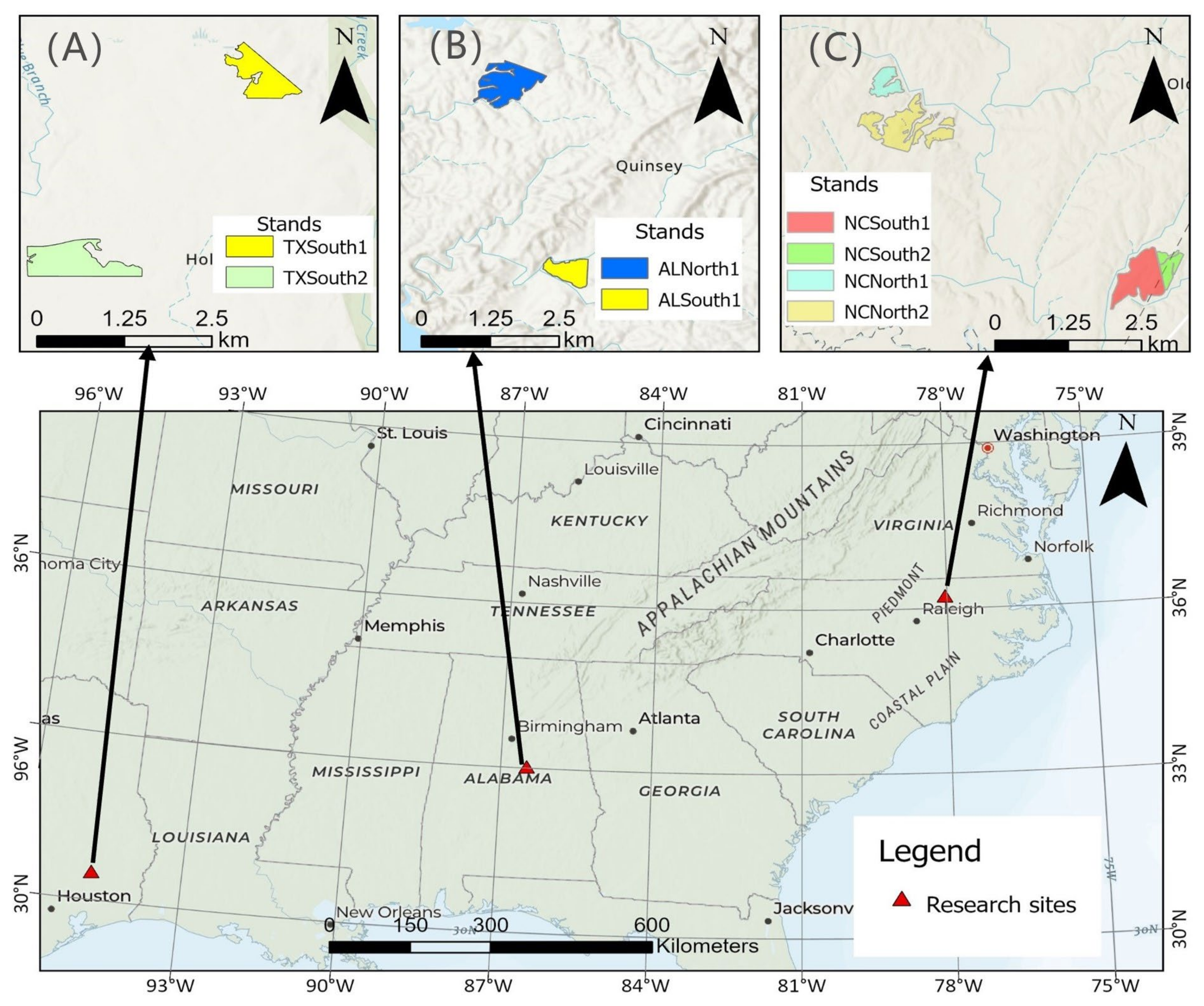
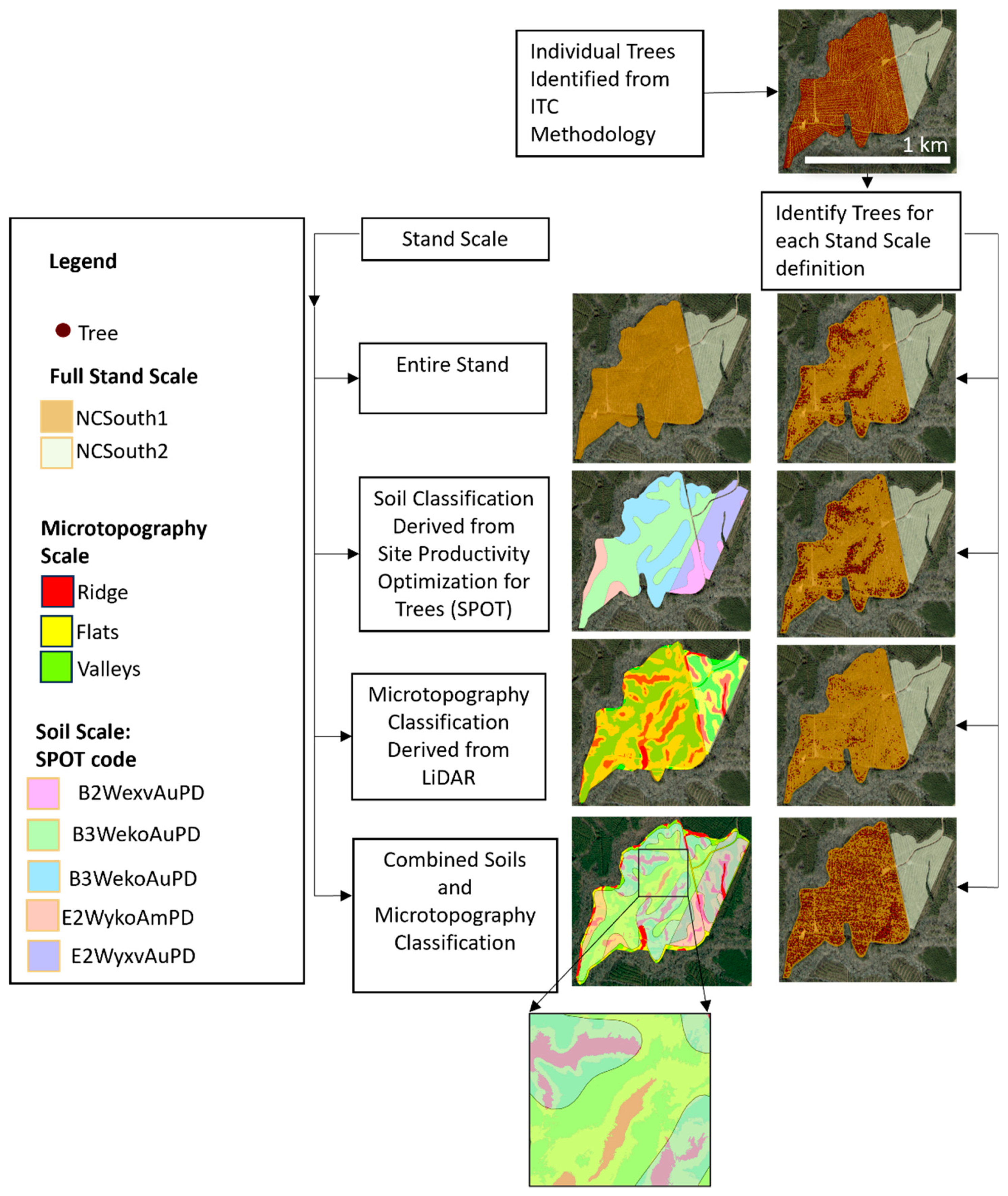

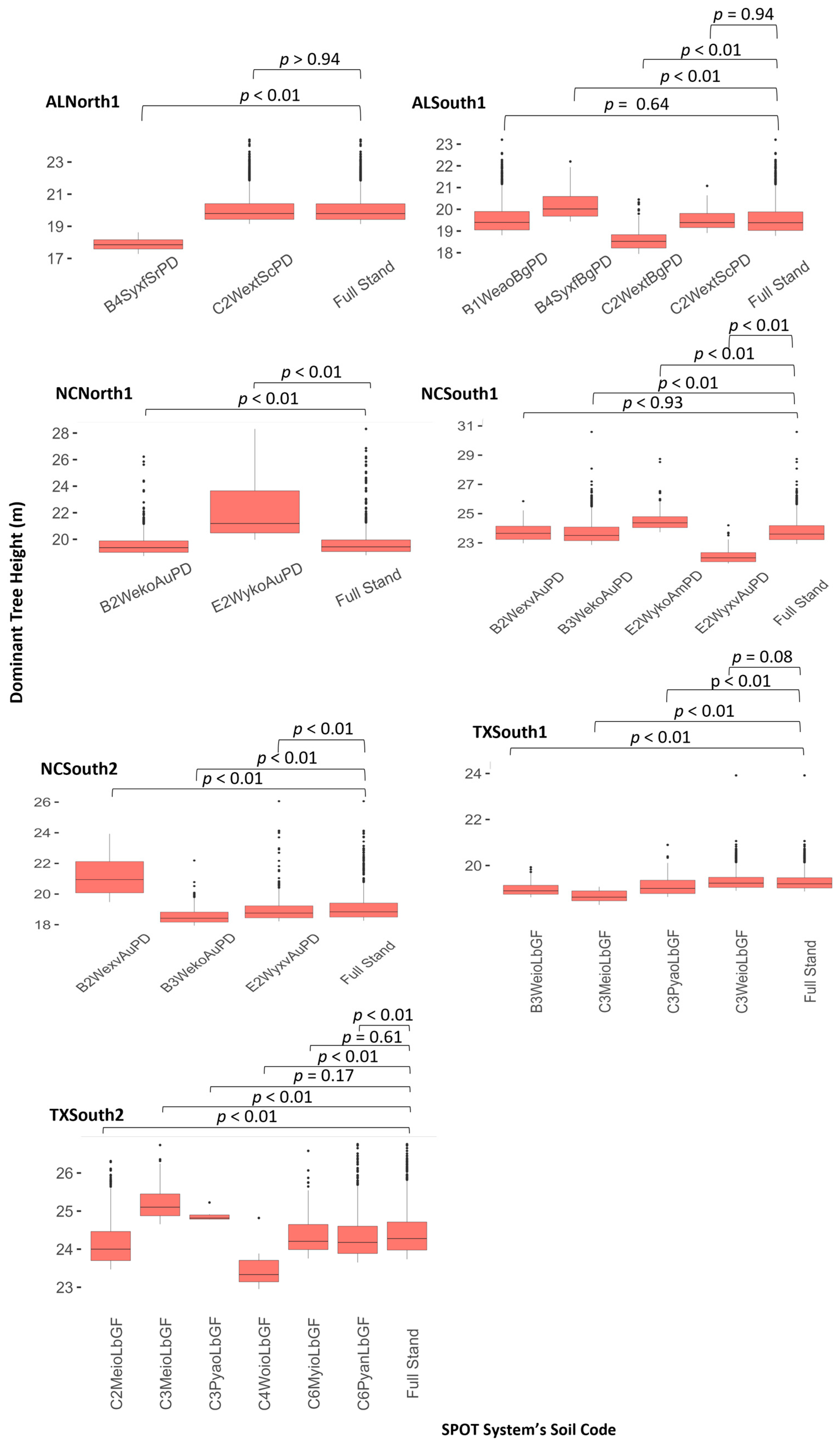
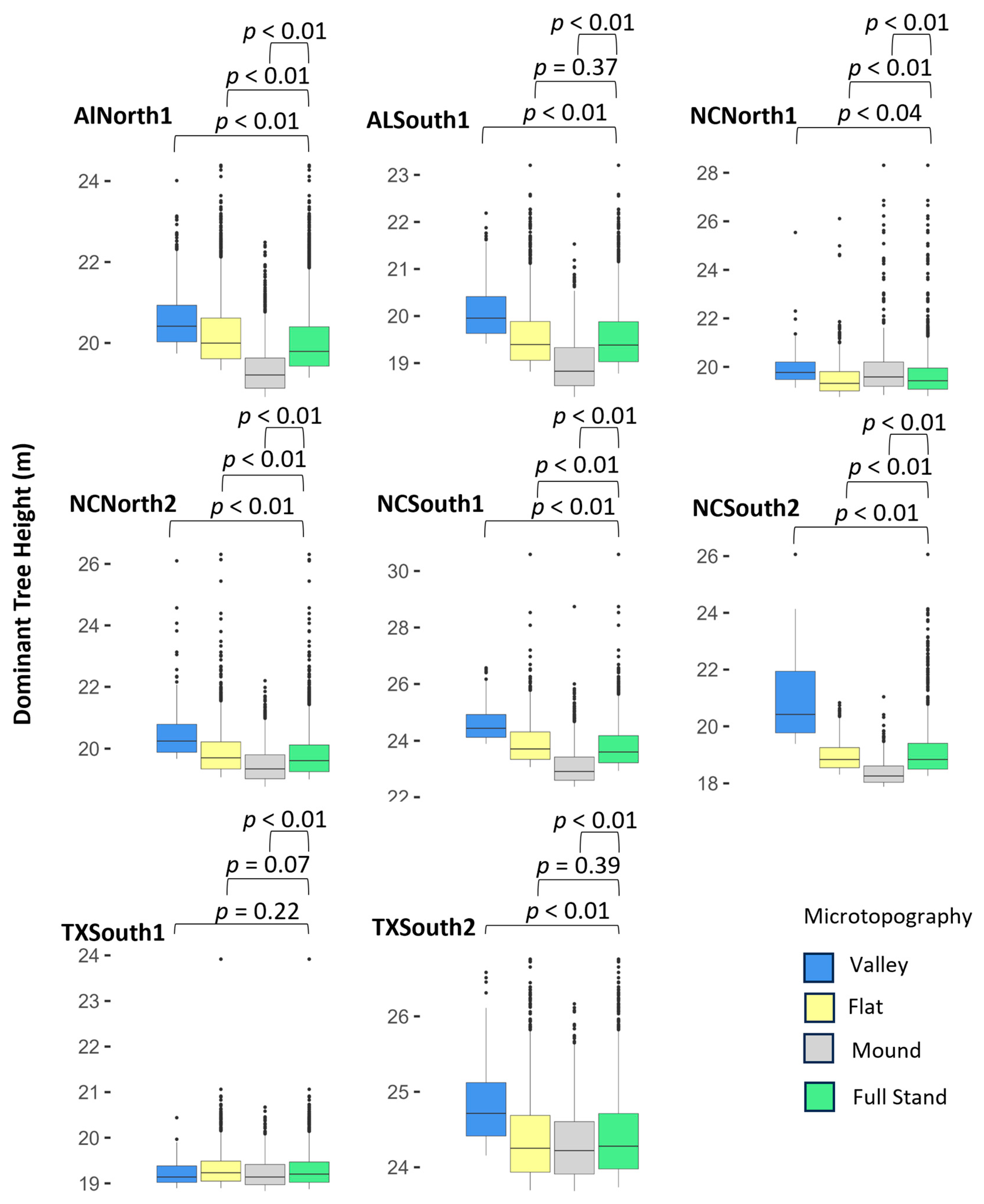
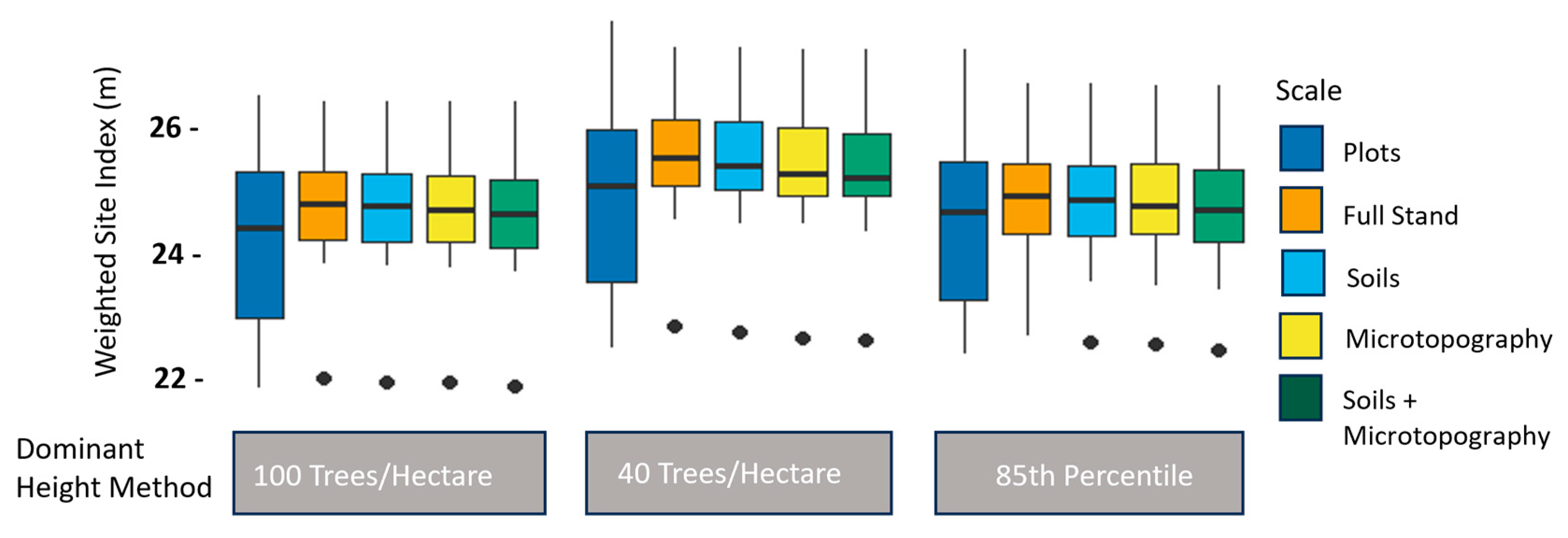
| Location | Mean Annual Precipitation (mm) | Mean Annual Temperature (°C) | Mean Annual Maximum Temperature (°C) | Mean Annual Minimum Temperature (°C) |
|---|---|---|---|---|
| Alabama | 1298 | 17.3 | 33.8 | 0.2 |
| North Carolina | 1154 | 15.6 | 33.1 | −2.1 |
| Texas | 1241 | 20.1 | 35.6 | 3.4 |
| State | Stand | Area (ha) | Year Planted | Age at Treatment (Years) | Tree Density after Thinning (Trees/ha) | Elevation Range above Sea Level (m) |
|---|---|---|---|---|---|---|
| AL | ALNorth1 | 49.1 | 2001 | 19 | 733 | 127.1–168.5 |
| ALSouth1 | 20.4 | 2002 | 18 | 941 | 118.8–146.0 | |
| NC | NCNorth1 | 16.7 | 2003 | 18 | 443 | 58.8–88.9 |
| NCNorth2 | 56.5 | 2005 | 16 | 403 | 55.7–88.9 | |
| NCSouth1 | 51.5 | 1994 | 27 | 298 | 52.0–78.9 | |
| NCSouth2 | 13.0 | 2004 | 17 | 401 | 60.4–79.5 | |
| TX | TXSouth1 | 52.3 | 2004 | 17 | 577 | 49.3–57.4 |
| TXSouth2 | 35.8 | 1999 | 22 | 411 | 42.0–49.2 |
| Site | Stand | Soil Type (FPC SPOT Codes) |
|---|---|---|
| AL | ALNorth1 | B4SyxfSrPD and C2WextScPD |
| ALSouth1 | B1WeaoBgPD, B4SyxfBgPD, C2WextBgPD, and C2WextScPD | |
| NC | NCNorth1 | B2WekoAuPD and E2WykoAuPD |
| NCNorth2 | B2WekoAuPD | |
| NCSouth1 | B2WexvAuPD, B3WekoAuPD, E2WykoAmPD, and E2WyxvAuPD | |
| NCSouth2 | B2WexvAuPD, B3WekoAuPD, and E2WyxvAuPD | |
| TX | TXSouth1 | B3WeioLbGF, C3MeioLbGF, C3PyaoLbGF, and C3WeioLbGF |
| TXSouth2 | C2MeioLbGF, C3MeioLbGF, C3PyaoLbGF, C4WoioLbGF, C6MyioLbGF, and C6PyanLbGF |
| Location | Dates of Collection | Sensor | Pulse Density | Flight Line Overlap |
|---|---|---|---|---|
| AL | January 2020 | Riegl 1560ii | 26 pulses/m2 | 60% |
| NC | July 2021 | Riegl MiniVux1 | 20 pulses/m2 | 80% |
| TX | January–March 2021 | Riegl VQ-480 II | 289 to 493 pulses/m2 | 55% |
| State | Stand | Soil | Flat | Mound | Valley | Sub Total |
|---|---|---|---|---|---|---|
| AL | ALNorth1 | B4SyxfSrPD | −9% | −11% | ||
| C2WextScPD | 1% | −3% | 3% | 0% | ||
| Sub Total | 3% | −3% | 3% | 20.2 m | ||
| ALSouth1 | B1WeaoBgPD | 0% | −3% | 3% | 0% | |
| B4SyxfBgPD | 4% | −12% | −2% | 3% | ||
| C2WextBgPD | −7% | −7% | −5% | |||
| C2WextScPD | −1% | −8% | 2% | 0% | ||
| Sub Total | 0% | −3% | 3% | 19.6 m |
| State | Stand | Soil | Flat | Mound | Valley | Sub Total |
|---|---|---|---|---|---|---|
| NC | NCNorth1 | B2WekoAuPD | −1% | 0% | 1% | −1% |
| E2WykoAuPD | 8% | 16% | 0% | 13% | ||
| Sub Total | −1% | −1% | 2% | 19.7 m | ||
| NCNorth2 | B2WekoAuPD | 0% | −2% | 3% | 0% | |
| Sub Total | 0% | −2% | 3% | 19.8 m | ||
| NCSouth1 | B2WexvAuPD | 1% | −5% | −3% | 0% | |
| B3WekoAuPD | 0% | −3% | 3% | 0% | ||
| E2WykoAmPD | 3% | 2% | 5% | 3% | ||
| E2WyxvAuPD | −7% | −7% | −7% | −7% | ||
| Sub Total | 0% | −3% | 3% | 23.8 m | ||
| NCSouth2 | B2WexvAuPD | 1% | −2% | 18% | 11% | |
| B3WekoAuPD | −2% | −5% | 0% | −3% | ||
| E2WyxvAuPD | −1% | −4% | 6% | −1% | ||
| Sub Total | −1% | −4% | 10% | 19.1 m |
| State | Stand | Soil | Flat | Mound | Valley | Sub Total |
|---|---|---|---|---|---|---|
| TX | TXSouth1 | B3WeioLbGF | −1% | 1% | −3% | −2% |
| C3MeioLbGF | −6% | −2% | 0% | −3% | ||
| C3PyaoLbGF | −1% | 0% | 1% | −1% | ||
| C3WeioLbGF | 0% | 0% | −1% | 0% | ||
| Sub Total | 0% | 0% | 0% | 19.3 m | ||
| TXSouth2 | C2MeioLbGF | −2% | −2% | 2% | −1% | |
| C3MeioLbGF | 4% | 3% | 2% | 3% | ||
| C3PyaoLbGF | #NAME? | 0% | 0% | 2% | ||
| C4WoioLbGF | −4% | −5% | 0% | −4% | ||
| C6MyioLbGF | −1% | 0% | 2% | 0% | ||
| C6PyanLbGF | 0% | −1% | 0% | 0% | ||
| Sub Total | 0% | 0% | 2% | 24.4 m |
| Stand Scale | Soils | Microtopography | Soils and Microtopography | Plot Simulation |
|---|---|---|---|---|
| Full Stand | 0.0225 | 0.0547 | 0.0078 | 0.2500 |
| Soils | 0.6406 | 0.0078 | 0.3828 | |
| Microtopography | 0.0225 | 0.3125 | ||
| Soils and Microtopography | 0.6406 |
Disclaimer/Publisher’s Note: The statements, opinions and data contained in all publications are solely those of the individual author(s) and contributor(s) and not of MDPI and/or the editor(s). MDPI and/or the editor(s) disclaim responsibility for any injury to people or property resulting from any ideas, methods, instructions or products referred to in the content. |
© 2024 by the authors. Licensee MDPI, Basel, Switzerland. This article is an open access article distributed under the terms and conditions of the Creative Commons Attribution (CC BY) license (https://creativecommons.org/licenses/by/4.0/).
Share and Cite
Raigosa-García, I.; Rathbun, L.C.; Cook, R.L.; Baker, J.S.; Corrao, M.V.; Sumnall, M.J. Rethinking Productivity Evaluation in Precision Forestry through Dominant Height and Site Index Measurements Using Aerial Laser Scanning LiDAR Data. Forests 2024, 15, 1002. https://doi.org/10.3390/f15061002
Raigosa-García I, Rathbun LC, Cook RL, Baker JS, Corrao MV, Sumnall MJ. Rethinking Productivity Evaluation in Precision Forestry through Dominant Height and Site Index Measurements Using Aerial Laser Scanning LiDAR Data. Forests. 2024; 15(6):1002. https://doi.org/10.3390/f15061002
Chicago/Turabian StyleRaigosa-García, Iván, Leah C. Rathbun, Rachel L. Cook, Justin S. Baker, Mark V. Corrao, and Matthew J. Sumnall. 2024. "Rethinking Productivity Evaluation in Precision Forestry through Dominant Height and Site Index Measurements Using Aerial Laser Scanning LiDAR Data" Forests 15, no. 6: 1002. https://doi.org/10.3390/f15061002
APA StyleRaigosa-García, I., Rathbun, L. C., Cook, R. L., Baker, J. S., Corrao, M. V., & Sumnall, M. J. (2024). Rethinking Productivity Evaluation in Precision Forestry through Dominant Height and Site Index Measurements Using Aerial Laser Scanning LiDAR Data. Forests, 15(6), 1002. https://doi.org/10.3390/f15061002








